The first private city in Russia. Part 3
In this article we will talk with a lawyer about the possibility of creating a private city from a legal point of view, then we will discuss the layout of the city and the IT technologies applicable in it.
→ Introductory article
→ Part 1
→ Part 2

A private city is the most autonomous city in which a large private company (management company) takes control. Such a city is legitimate and is fully subordinate to the federal laws of the Russian Federation, but introduces additional rules to maintain order and a high level of comfort in its territory, which is not characteristic of state cities. Residents pay a monthly fee for living in its territory. The size of the fee (a kind of tax) depends on the cost of the purchased / rented housing. The systems of law and order and the courts in the city are state-owned, but medicine and education are completely or almost completely private and can be subsidized by the management company.
')
The city's economy was discussed in detail in the previous article , below I will answer the questions asked in the comments.
Why do I promote the idea of a private city?
We live at a time when almost all services in the city are provided by business. Every day we go to stores that have opened a business for us; then we go to restaurants or cafes that the business has built; after that we go to the cinema or amusement park created by the business. Almost everywhere we are surrounded by business. Yes, and many of us somehow work for private business or are themselves.
And what about the public sector?
Education.
This is the foundation that is laid in us and will be laid in our children. Each of us understands that in education now there are either patriots or those who simply have nowhere else to go to work. Good teachers for the money that they pay, do not want to work. The teaching profession is discredited. It does not even hide the authorities and openly says: “If you want to make money, go into business.” Add to this a high level of bureaucracy and red tape, which do not allow the introduction of modern training systems. And at the request of society in the country began to appear private schools and kindergartens. Well, those who can afford - send children to private schools in England.
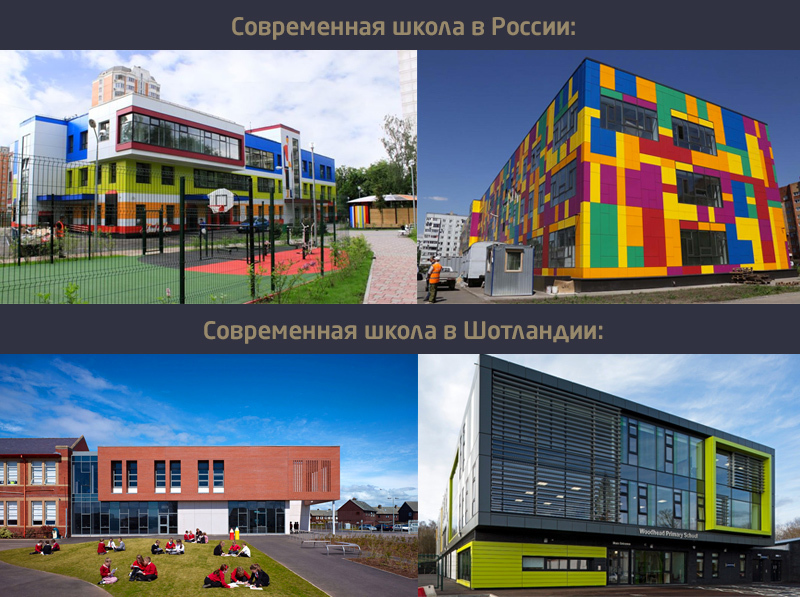
The medicine.
Everything is the same here. But the business has long responded to this. Dozens of private medical centers and laboratories are open in many large cities. From public hospitals, doctors go there. And if a person has the opportunity, he always goes to a private clinic. For the middle class, it is now quite accessible.
Well, if there is no money, get ready for rudeness and the lack of a modern service of the city hospital.
Private business has now begun to penetrate into other social infrastructure: toll roads appear, private management companies in the housing and utilities sector, private public transport.
All this is the response of society to the inability of the state to create and manage modern infrastructure.
And the culmination of this response may be the city at the head of a private company, which just takes the role of management in the city. The role that ineffective measures are now playing will be taken in better hands.
Is business always efficient and rational?
Not. Business can be divided into 2 categories:
And at the head of the manager of a private city should be the one who can distinguish one from the other. His task is to set the framework for the work of small and medium businesses. In this case, the city will develop harmoniously and efficiently.
Is it possible with the current legislation to build a private city in Russia?
 We will talk about this with lawyer Andrey Strokin. It is noteworthy that Andrei is now involved in the construction of a private cottage community near Vladivostok and is well acquainted with the nuances in this area.
We will talk about this with lawyer Andrey Strokin. It is noteworthy that Andrei is now involved in the construction of a private cottage community near Vladivostok and is well acquainted with the nuances in this area.
1. Is it possible to build a private city on the territory of the Russian Federation, whose management will be in the hands of a private company?
The construction of a private city on the territory of the Russian Federation is not prohibited, as there is no direct prohibition in this country’s legislation on this action.
There is a difficult and simple way, but the first one gives more advantages:
Representatives of a private company can be legally elected / appointed to state and local government bodies. After that, they will be able to make laws, approve the Land Use Rules of the development and manage the constructed city. However, this method is understandably time consuming.
A simple way to achieve this goal:
Having a land plot in the property and having received a town-planning plan in the local self-government bodies, having developed a general development plan for oneself, one can safely proceed to the beginning of construction. For the construction of objects on this land plot it is necessary to obtain a building permit, in cases where it is required for this object.
The construction can be carried out by a single developer at his own expense, or taking into account the funds raised (co-investors, equity holders). Since most of the territory remains in the ownership of a private company (roads, communications, fences, etc.), a private company receives the right to establish its own rules of conduct in the territory of a private city (the amount of rent for travel, accommodation, advertising, etc.). In order not to lose its own influence, a private company can take out its capital and non-capital construction objects, as well as lease land plots indicating their intended use, as well as register joint legal entities with a larger share of the private company in the charter capital.

This is how modern cities should look like.
2. Is it possible to introduce my own rules (not laws) in such a city?
Private companies may have the ability to approve certain rules of conduct for resident citizens and working legal entities on the territory of a private city due to contractual obligations.
3. Can such a city take rents for living on its territory and include them in utility bills?
The possibility of a private company collecting any payments from citizens and legal entities, such as rent for travel, accommodation, advertising, etc., may be stipulated in the adopted regulatory legal acts of the authorities, or agreements concluded with citizens and legal entities to manage the city .
4. Is it possible in the legal field to regulate the rules of building for business? For example, an entrepreneur wants to put a car wash-shed. The city says to him: the barn is impossible, make a modern building that will fit into the surrounding architectural style.

The rules of land use and development are approved by the representative body of local self-government (Article 32 of the Town Planning Code of the Russian Federation). Therefore, the owner of the land has the right to dispose of it himself and may violate the rules of the city, but not the laws of the municipal district. In order to have all the rights to constructed facilities in the territory of a private city, it is necessary either to lease the land, or to be a shareholder / co-investor of the building.
Conclusion
From the above, we can conclude: you can build a private city in the territory of the Russian Federation. For obvious reasons, such a city must comply with the requirements of the current legislation of the country, but it can implement its own rules. Conventionally: a restaurant owner may ban entry to a dog and indicate any prices on the menu, the state does not affect this, but at the same time he cannot but let a person in a wheelchair because it is contrary to the constitution.
What is fundamentally different private city besides the fact that he will be running a business? I bring to your attention my concept and vision. This is not the final version and any of you can contribute your ideas.
The basis is the concept of " new urbanism ", when the key infrastructure of the city is located within walking distance (10 min. Walk).
 The city will not be the center and there will be no sleeping areas, the building is mixed. This will eliminate the main cause of traffic jams in cities - pendulum migration. Each hex (city cell) has almost everything you need: residential areas, commercial real estate, school, gardens, small parks, sports fields.
The city will not be the center and there will be no sleeping areas, the building is mixed. This will eliminate the main cause of traffic jams in cities - pendulum migration. Each hex (city cell) has almost everything you need: residential areas, commercial real estate, school, gardens, small parks, sports fields.
This city will be primarily focused on pedestrians and cyclists, and only then on motorists. For those who have now asked the question "Why?", I advise you to read the book "Cities for People" by Jan Gale . I will deal with this topic in more detail in the following articles.
The buildings in the city are designed according to the principle of quarters , this allows to separate the private territory (courtyard) from the public by the form of the building itself. In the planning on the basis of microdistricts, due to the lack of such a distinction, the inhabitants put fences, which does not add convenience to the city and create an aggressive environment of “friend or foe”.
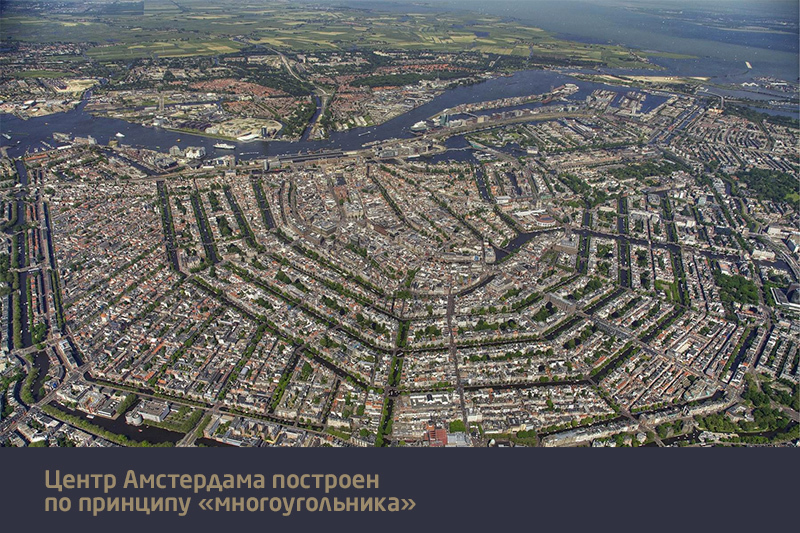
The layout of the city is made in the form of hexagons. About why this particular form was chosen I wrote in the first article . In short, the mathematical model shows that such a form creates fewer traffic jams, even when compared to classic quarters.
The second plus is that this form does not allow to develop high speeds in the city due to frequent turns, while increasing the safety of residents.
Also, this form gives an indirect advantage - from a psychological point of view, the streets with an infinitely stretching road to the horizon seem very long and routine, you want to walk along them less than those where a person sees at the end of the street.
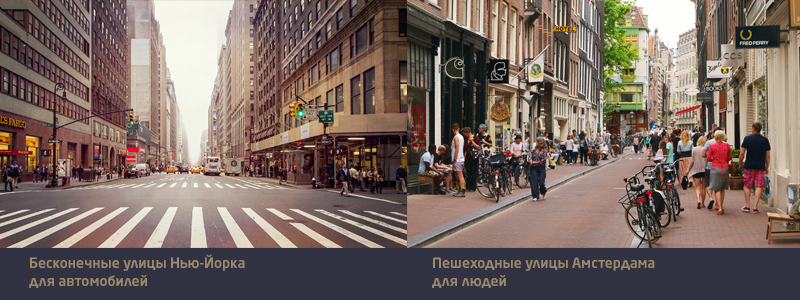
Let's look at one hexagon (cluster) taken separately:
Its diameter is 1 km. The population is 10,000 people.
Low-rise buildings (on average 4-5 floors).
Along the perimeter are:
- offices and coworking
- hotels
- catering (cafes, restaurants)
- entertainment (bars, night clubs)
- schools
- medical centers
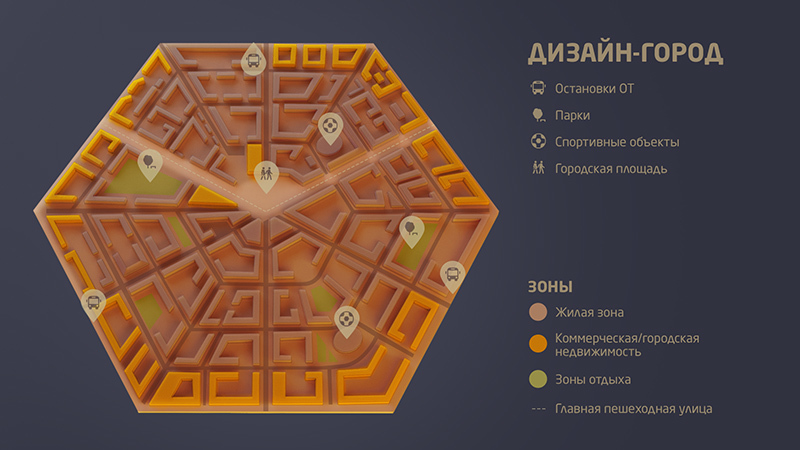
This is not done by chance.
First, the key infrastructure is close to the road network, so if, for example, you come from another point of the city to a medical center, there is no need to go deep into the hex.
Secondly, if we make the city a tourist destination, this approach will save the residents from the crowds of tourists who would go deep into the hexagon and also protect them from the noise of the nightlife of the city (bars, nightclubs, main traffic flows).
Within the perimeter of the hexagon, the infrastructure already needed by the residents is mainly located on the first floors of the buildings:
- grocery stores, cooking
- pharmacies
- workshops (for tailoring, for example)
- hairdressing, beauty salons
- GYM's
- squares
- sports grounds
and other
On 3 sides of the hex there are public transport stops. From any point of the cluster the distance to the nearest stop will not exceed 500 meters.
Through traffic in the hex is impossible, but you can drive up to each house from the outside. Courtyards will be given to playgrounds, gazebos and landscaping. Only special equipment will be able to enter them in case of emergency. Almost all houses will be equipped with underground parking. Given the low-rise construction, this approach will fully cover the needs of residents in parking lots.
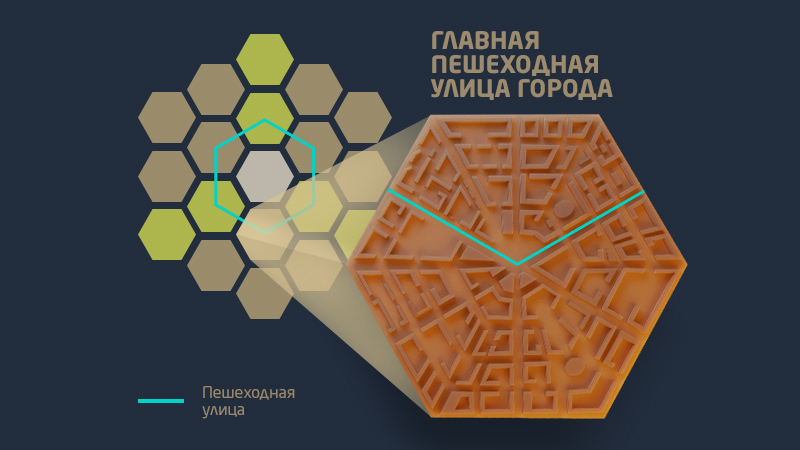
In the center of the hexagon there is one large pedestrian road, which connecting with the neighboring, creates a huge pedestrian zone. This is the main tourist route that will connect all the park areas.
The city is designed so that each district-hexagon has access to at least one large park (central areas to two).
If you look at the scheme of the city, you will notice that there is no clearly traceable and repeatedly repeated layout of buildings. This is also not a coincidence. I think that this is exactly what a living environment should look like for people. This is how old cities are formed and, as practice shows, they are the most comfortable. In such quarters it is easy to find the right house, because the shape of all the building is diverse, but the streets are logical and not turned into a maze of disconnected streets and dead ends. And if we design a city for robots, then it is quite possible to do so, as in the well-known “Venus Project”:
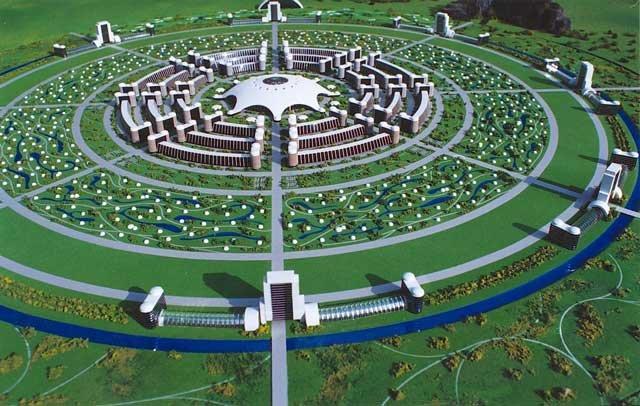
What looks beautiful from above does not always look good from a height of human growth.
What technologies can we build into the city so that it is efficient, modern and logical?
My suggestion is to reduce bureaucratic delays as much as possible when living in a private city with the help of uniform urban applications. It can be done on the basis of the blockchain technology to protect the residents' data from fraud.
The application "Citizen" will allow:
- quickly move from one cluster to another;
- pay in one click all types of utilities;
- track the expenditure of the HOA or the Managing Company, for example, for the overhaul (what was done in the house and what materials);
- look for a new job;
- receive alerts about major events in the city.

Smart move
I am sure that the first residents will hardly buy apartments. After all, the format of the city is completely new. What will happen to him in a year or 5 years? Therefore, the practice of renting housing and commercial premises will develop. Do not like it - you can leave.
Rent is a flexible format for living in the city. You can always quickly change the location and move closer to work. But relocation always entails a lot of side effects: to find the apartment itself, if there is a child - you need to arrange it in a new kindergarten or school, transport things, reissue documents.
In the application "Citizen" you just need to specify the cluster in which you want to move and you automatically get in line for living in this cluster. At the same time, the application takes into account the factors of availability in kindergarten or school, the nearest infrastructure objects that you set as important.
Once the desired apartment is found - in one click we reissue documents to a new location, the child is automatically enrolled in a kindergarten / school and you are offered the services of transporting things to the desired apartment.
I always get tired of walking around the apartment and recording the meter readings. Now there are counters to which you can connect via WiFi. And why then not to transfer their values to the city application and once a month just press the "Pay" button? It is convenient and fast. No more waste paper in the mail. For the older generation, of course, you can leave the traditional option with receipts.
Unified city application "Transport"
In this application you can:
- see a map of the transport infrastructure in the city;
- see where your bus is traveling in real time and immediately get a hint if you manage to walk to the bus stop and catch the bus or do you need to wait for the next one;
- quickly find a free bike for rent;
- rent a car sharing car.
Unified city application "Real Estate"
In this application, you will always be aware of the construction of new facilities of the city. You will learn the stage of readiness and you will be able to decide in advance about moving to a better apartment. You will find out that a swimming pool will open next to your house in 3 months, and in a month there will be a small polyclinic.
This will be possible only because the private city will be aware of the introduction of new facilities on its territory and that it will give permission to small and medium businesses to start their work in the city.
And what kind of IT technology would you like in your city?
If you have read to the end and have already prepared to write a comment like “This is utopia”, “This will never be built in Russia”, then slow down.
I will tell you one interesting fairy tale.
It turns out that this is not a fairy tale and the above described city really exists . So much for utopia, gentlemen.
I am creating this project in case there will be such a person or several. In this case, these people will already have a ready-made concept created by our community and formed demand for such a “product”.
Demand creates supply, not vice versa. And we form this demand for a comfortable environment. And while developers are building trash on the technologies of the 90s , and we buy it , then nothing will change , believe me.
I remind you that this is a concept and it requires further development and the participation of the society itself. Each of you can make a contribution, each of us has our own unique experience and connections. Together we can build a huge networking.
Offer your ideas to the VC, FB groups and follow the target on SmartProgress.



Navigation
→ Introductory article
→ Part 1
→ Part 2

What is a private city and why is it needed?
A private city is the most autonomous city in which a large private company (management company) takes control. Such a city is legitimate and is fully subordinate to the federal laws of the Russian Federation, but introduces additional rules to maintain order and a high level of comfort in its territory, which is not characteristic of state cities. Residents pay a monthly fee for living in its territory. The size of the fee (a kind of tax) depends on the cost of the purchased / rented housing. The systems of law and order and the courts in the city are state-owned, but medicine and education are completely or almost completely private and can be subsidized by the management company.
')
The city's economy was discussed in detail in the previous article , below I will answer the questions asked in the comments.
Why do I promote the idea of a private city?
We live at a time when almost all services in the city are provided by business. Every day we go to stores that have opened a business for us; then we go to restaurants or cafes that the business has built; after that we go to the cinema or amusement park created by the business. Almost everywhere we are surrounded by business. Yes, and many of us somehow work for private business or are themselves.
And what about the public sector?
Education.
This is the foundation that is laid in us and will be laid in our children. Each of us understands that in education now there are either patriots or those who simply have nowhere else to go to work. Good teachers for the money that they pay, do not want to work. The teaching profession is discredited. It does not even hide the authorities and openly says: “If you want to make money, go into business.” Add to this a high level of bureaucracy and red tape, which do not allow the introduction of modern training systems. And at the request of society in the country began to appear private schools and kindergartens. Well, those who can afford - send children to private schools in England.

The medicine.
Everything is the same here. But the business has long responded to this. Dozens of private medical centers and laboratories are open in many large cities. From public hospitals, doctors go there. And if a person has the opportunity, he always goes to a private clinic. For the middle class, it is now quite accessible.
Well, if there is no money, get ready for rudeness and the lack of a modern service of the city hospital.
Private business has now begun to penetrate into other social infrastructure: toll roads appear, private management companies in the housing and utilities sector, private public transport.
All this is the response of society to the inability of the state to create and manage modern infrastructure.
And the culmination of this response may be the city at the head of a private company, which just takes the role of management in the city. The role that ineffective measures are now playing will be taken in better hands.
Is business always efficient and rational?
Not. Business can be divided into 2 categories:
- those who want to quickly cut the cache without worrying about the quality
- those who develop customer service and improve the product, simultaneously earning money
And at the head of the manager of a private city should be the one who can distinguish one from the other. His task is to set the framework for the work of small and medium businesses. In this case, the city will develop harmoniously and efficiently.
Legal status
Is it possible with the current legislation to build a private city in Russia?
 We will talk about this with lawyer Andrey Strokin. It is noteworthy that Andrei is now involved in the construction of a private cottage community near Vladivostok and is well acquainted with the nuances in this area.
We will talk about this with lawyer Andrey Strokin. It is noteworthy that Andrei is now involved in the construction of a private cottage community near Vladivostok and is well acquainted with the nuances in this area.Interview
1. Is it possible to build a private city on the territory of the Russian Federation, whose management will be in the hands of a private company?
The construction of a private city on the territory of the Russian Federation is not prohibited, as there is no direct prohibition in this country’s legislation on this action.
There is a difficult and simple way, but the first one gives more advantages:
Representatives of a private company can be legally elected / appointed to state and local government bodies. After that, they will be able to make laws, approve the Land Use Rules of the development and manage the constructed city. However, this method is understandably time consuming.
A simple way to achieve this goal:
Having a land plot in the property and having received a town-planning plan in the local self-government bodies, having developed a general development plan for oneself, one can safely proceed to the beginning of construction. For the construction of objects on this land plot it is necessary to obtain a building permit, in cases where it is required for this object.
The construction can be carried out by a single developer at his own expense, or taking into account the funds raised (co-investors, equity holders). Since most of the territory remains in the ownership of a private company (roads, communications, fences, etc.), a private company receives the right to establish its own rules of conduct in the territory of a private city (the amount of rent for travel, accommodation, advertising, etc.). In order not to lose its own influence, a private company can take out its capital and non-capital construction objects, as well as lease land plots indicating their intended use, as well as register joint legal entities with a larger share of the private company in the charter capital.

This is how modern cities should look like.
2. Is it possible to introduce my own rules (not laws) in such a city?
Private companies may have the ability to approve certain rules of conduct for resident citizens and working legal entities on the territory of a private city due to contractual obligations.
3. Can such a city take rents for living on its territory and include them in utility bills?
The possibility of a private company collecting any payments from citizens and legal entities, such as rent for travel, accommodation, advertising, etc., may be stipulated in the adopted regulatory legal acts of the authorities, or agreements concluded with citizens and legal entities to manage the city .
4. Is it possible in the legal field to regulate the rules of building for business? For example, an entrepreneur wants to put a car wash-shed. The city says to him: the barn is impossible, make a modern building that will fit into the surrounding architectural style.

The rules of land use and development are approved by the representative body of local self-government (Article 32 of the Town Planning Code of the Russian Federation). Therefore, the owner of the land has the right to dispose of it himself and may violate the rules of the city, but not the laws of the municipal district. In order to have all the rights to constructed facilities in the territory of a private city, it is necessary either to lease the land, or to be a shareholder / co-investor of the building.
Conclusion
From the above, we can conclude: you can build a private city in the territory of the Russian Federation. For obvious reasons, such a city must comply with the requirements of the current legislation of the country, but it can implement its own rules. Conventionally: a restaurant owner may ban entry to a dog and indicate any prices on the menu, the state does not affect this, but at the same time he cannot but let a person in a wheelchair because it is contrary to the constitution.
City planning
What is fundamentally different private city besides the fact that he will be running a business? I bring to your attention my concept and vision. This is not the final version and any of you can contribute your ideas.
Design City
The basis is the concept of " new urbanism ", when the key infrastructure of the city is located within walking distance (10 min. Walk).
 The city will not be the center and there will be no sleeping areas, the building is mixed. This will eliminate the main cause of traffic jams in cities - pendulum migration. Each hex (city cell) has almost everything you need: residential areas, commercial real estate, school, gardens, small parks, sports fields.
The city will not be the center and there will be no sleeping areas, the building is mixed. This will eliminate the main cause of traffic jams in cities - pendulum migration. Each hex (city cell) has almost everything you need: residential areas, commercial real estate, school, gardens, small parks, sports fields.This city will be primarily focused on pedestrians and cyclists, and only then on motorists. For those who have now asked the question "Why?", I advise you to read the book "Cities for People" by Jan Gale . I will deal with this topic in more detail in the following articles.
The buildings in the city are designed according to the principle of quarters , this allows to separate the private territory (courtyard) from the public by the form of the building itself. In the planning on the basis of microdistricts, due to the lack of such a distinction, the inhabitants put fences, which does not add convenience to the city and create an aggressive environment of “friend or foe”.
About neighborhoods
Microdistrict - the paradigm of Russian urban planning since the early 1960s. Then the idea seemed fresh and fashionable: instead of small "capitalist" neighborhoods - huge territorial units, residential neighborhoods. They were made up of freely located multi-storey residential buildings and social and cultural buildings and presented a concept from the future. The architects were fascinated by the change of scale: if the quarter occupied an area of one hundred by one hundred meters, then the microdistrict represented a structure with a length of one kilometer. If in the quarter the buildings were located along the perimeter, along the street, then in the microdistrict multi-storey buildings were arranged chaotically, without following any rules, this created a feeling of freedom.
The modernist urban development paradigm of the neighborhood came to the Soviet Union from Europe: in the 1950s and 1960s, cities affected by the war were built in this way. The microdistrict concept was well combined with the idea of panel housing construction - it was necessary to build a lot and quickly. However, by the early 1970s, Europe began to abandon housing estates, and a little later, to demolish them. Why?
The shortcomings of the neighborhood by that time had already become completely obvious. Such a building is not proportionate to man. Large houses are crushing, huge empty spaces are difficult to master psychologically - they remain alien. Large public courtyards can be humanized, but it is very costly, and in practice they turn out to be just huge and uncomfortable wastelands. In most cases, multi-storey buildings are monotonous, which adversely affects people's mental health. The neighborhood, sandwiched between two major highways, turned out to be less efficient in the transport sense than a quarterly structure with a system of small streets. The division of the city into mono-functional residential neighborhoods and business districts dramatically increased the transport movement of citizens.
Finally, there was no community in the neighborhood: people were alienated from each other. Together, this contributed to the growth of crime in such areas. In France, the connection between crime and inhumane living environment of panel neighborhoods is today a commonplace in the discourse of urbanists.
The modernist urban development paradigm of the neighborhood came to the Soviet Union from Europe: in the 1950s and 1960s, cities affected by the war were built in this way. The microdistrict concept was well combined with the idea of panel housing construction - it was necessary to build a lot and quickly. However, by the early 1970s, Europe began to abandon housing estates, and a little later, to demolish them. Why?
The shortcomings of the neighborhood by that time had already become completely obvious. Such a building is not proportionate to man. Large houses are crushing, huge empty spaces are difficult to master psychologically - they remain alien. Large public courtyards can be humanized, but it is very costly, and in practice they turn out to be just huge and uncomfortable wastelands. In most cases, multi-storey buildings are monotonous, which adversely affects people's mental health. The neighborhood, sandwiched between two major highways, turned out to be less efficient in the transport sense than a quarterly structure with a system of small streets. The division of the city into mono-functional residential neighborhoods and business districts dramatically increased the transport movement of citizens.
Finally, there was no community in the neighborhood: people were alienated from each other. Together, this contributed to the growth of crime in such areas. In France, the connection between crime and inhumane living environment of panel neighborhoods is today a commonplace in the discourse of urbanists.

The layout of the city is made in the form of hexagons. About why this particular form was chosen I wrote in the first article . In short, the mathematical model shows that such a form creates fewer traffic jams, even when compared to classic quarters.
The second plus is that this form does not allow to develop high speeds in the city due to frequent turns, while increasing the safety of residents.
Also, this form gives an indirect advantage - from a psychological point of view, the streets with an infinitely stretching road to the horizon seem very long and routine, you want to walk along them less than those where a person sees at the end of the street.

Let's look at one hexagon (cluster) taken separately:
Its diameter is 1 km. The population is 10,000 people.
Low-rise buildings (on average 4-5 floors).
Along the perimeter are:
- offices and coworking
- hotels
- catering (cafes, restaurants)
- entertainment (bars, night clubs)
- schools
- medical centers

This is not done by chance.
First, the key infrastructure is close to the road network, so if, for example, you come from another point of the city to a medical center, there is no need to go deep into the hex.
Secondly, if we make the city a tourist destination, this approach will save the residents from the crowds of tourists who would go deep into the hexagon and also protect them from the noise of the nightlife of the city (bars, nightclubs, main traffic flows).
Within the perimeter of the hexagon, the infrastructure already needed by the residents is mainly located on the first floors of the buildings:
- grocery stores, cooking
- pharmacies
- workshops (for tailoring, for example)
- hairdressing, beauty salons
- GYM's
- squares
- sports grounds
and other
On 3 sides of the hex there are public transport stops. From any point of the cluster the distance to the nearest stop will not exceed 500 meters.
Through traffic in the hex is impossible, but you can drive up to each house from the outside. Courtyards will be given to playgrounds, gazebos and landscaping. Only special equipment will be able to enter them in case of emergency. Almost all houses will be equipped with underground parking. Given the low-rise construction, this approach will fully cover the needs of residents in parking lots.

In the center of the hexagon there is one large pedestrian road, which connecting with the neighboring, creates a huge pedestrian zone. This is the main tourist route that will connect all the park areas.
The city is designed so that each district-hexagon has access to at least one large park (central areas to two).
If you look at the scheme of the city, you will notice that there is no clearly traceable and repeatedly repeated layout of buildings. This is also not a coincidence. I think that this is exactly what a living environment should look like for people. This is how old cities are formed and, as practice shows, they are the most comfortable. In such quarters it is easy to find the right house, because the shape of all the building is diverse, but the streets are logical and not turned into a maze of disconnected streets and dead ends. And if we design a city for robots, then it is quite possible to do so, as in the well-known “Venus Project”:

What looks beautiful from above does not always look good from a height of human growth.
IT in the service of residents
What technologies can we build into the city so that it is efficient, modern and logical?
Single urban application "Citizen"
My suggestion is to reduce bureaucratic delays as much as possible when living in a private city with the help of uniform urban applications. It can be done on the basis of the blockchain technology to protect the residents' data from fraud.
The application "Citizen" will allow:
- quickly move from one cluster to another;
- pay in one click all types of utilities;
- track the expenditure of the HOA or the Managing Company, for example, for the overhaul (what was done in the house and what materials);
- look for a new job;
- receive alerts about major events in the city.

Smart move
I am sure that the first residents will hardly buy apartments. After all, the format of the city is completely new. What will happen to him in a year or 5 years? Therefore, the practice of renting housing and commercial premises will develop. Do not like it - you can leave.
Rent is a flexible format for living in the city. You can always quickly change the location and move closer to work. But relocation always entails a lot of side effects: to find the apartment itself, if there is a child - you need to arrange it in a new kindergarten or school, transport things, reissue documents.
In the application "Citizen" you just need to specify the cluster in which you want to move and you automatically get in line for living in this cluster. At the same time, the application takes into account the factors of availability in kindergarten or school, the nearest infrastructure objects that you set as important.
Once the desired apartment is found - in one click we reissue documents to a new location, the child is automatically enrolled in a kindergarten / school and you are offered the services of transporting things to the desired apartment.
Housing and communal services without hemorrhoids
I always get tired of walking around the apartment and recording the meter readings. Now there are counters to which you can connect via WiFi. And why then not to transfer their values to the city application and once a month just press the "Pay" button? It is convenient and fast. No more waste paper in the mail. For the older generation, of course, you can leave the traditional option with receipts.
Unified city application "Transport"
In this application you can:
- see a map of the transport infrastructure in the city;
- see where your bus is traveling in real time and immediately get a hint if you manage to walk to the bus stop and catch the bus or do you need to wait for the next one;
- quickly find a free bike for rent;
- rent a car sharing car.
Unified city application "Real Estate"
In this application, you will always be aware of the construction of new facilities of the city. You will learn the stage of readiness and you will be able to decide in advance about moving to a better apartment. You will find out that a swimming pool will open next to your house in 3 months, and in a month there will be a small polyclinic.
This will be possible only because the private city will be aware of the introduction of new facilities on its territory and that it will give permission to small and medium businesses to start their work in the city.
And what kind of IT technology would you like in your city?
A fairy tale for skeptics
If you have read to the end and have already prepared to write a comment like “This is utopia”, “This will never be built in Russia”, then slow down.
I will tell you one interesting fairy tale.
There once was a businessman VS He had a big business with its production in Russia and annual revenue of 21 billion rubles a year. Then one day he decided to invest personal money in the construction of a small city. Not less than 9 billion rubles, and he is still going to invest at least 13. That was his dream, you know?
It turns out that this is not a fairy tale and the above described city really exists . So much for utopia, gentlemen.
I am creating this project in case there will be such a person or several. In this case, these people will already have a ready-made concept created by our community and formed demand for such a “product”.
Demand creates supply, not vice versa. And we form this demand for a comfortable environment. And while developers are building trash on the technologies of the 90s , and we buy it , then nothing will change , believe me.
Prologue
I remind you that this is a concept and it requires further development and the participation of the society itself. Each of you can make a contribution, each of us has our own unique experience and connections. Together we can build a huge networking.
Offer your ideas to the VC, FB groups and follow the target on SmartProgress.



Source: https://habr.com/ru/post/402251/
All Articles